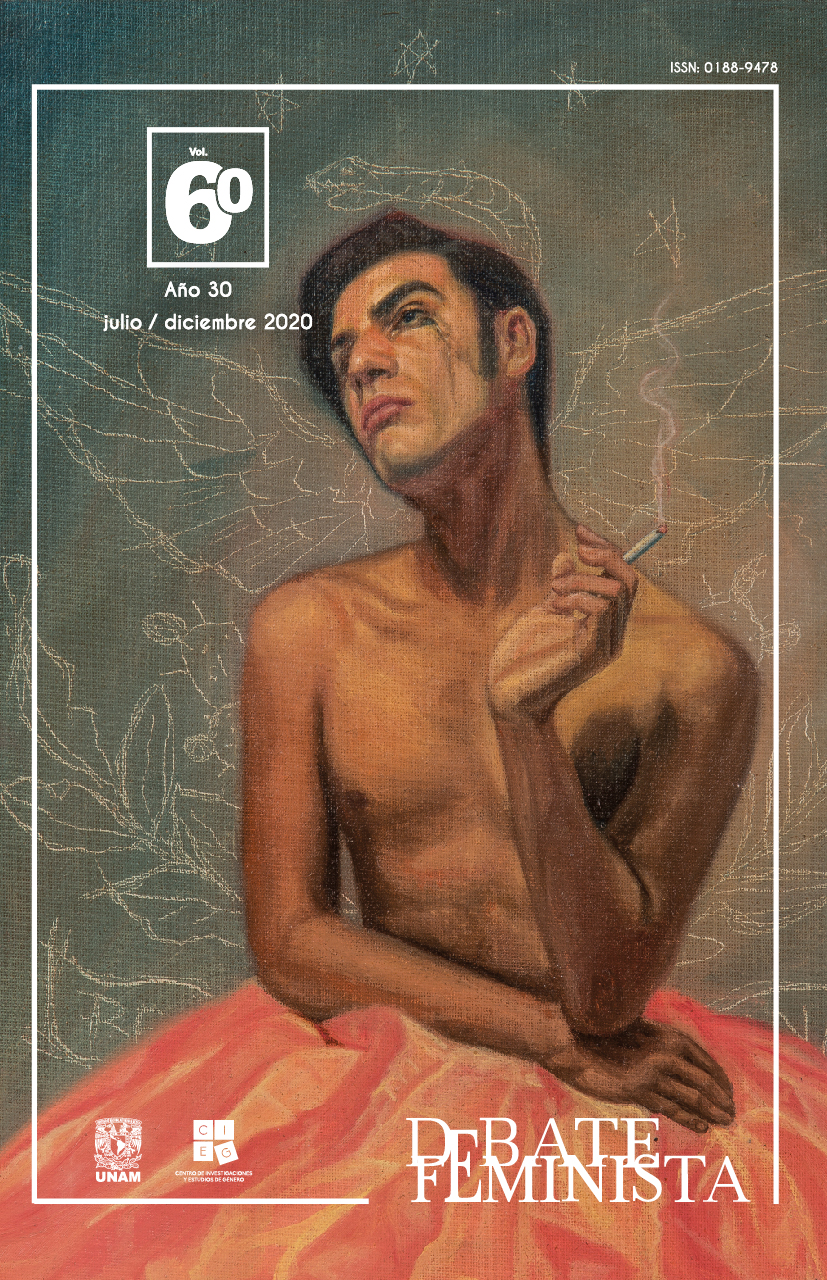Body-Camera-Eye: Presence and Intersubjectivity in the Work of the Artist Pola Weiss
Main Article Content
Abstract
Two works by the Mexican artist Pola Weiss (1947-1990) lead us to alternative ways of conceptualizing the aesthetic from the feminine/feminized body and the subversion of subject/object relationships. Weiss’ body-camera-eye expands beyond visuality and interrupts scopic hegemony to attempt to reveal what cannot be seen. Weiss’ aesthetic proposals are linked to other case studies which, from very different places, have made the body, its materiality and its affects, central elements of the epistemic and aesthetic experience. The potential of the hysterical body, the aesthetic theory of Lee and Anstruther-Thompson, and the problem of the cultural translation of the Nahuatl term ixiptlah, show other ways of understanding images, other logics capable of reinventing the ways we look and are looked at.
Keywords: Performance; Empathy; Body; Feminist Theory; Esthetic; Intersubjectivity
Article Details
Esta es una publicación bajo la licencia Creative Commons Attribution-Non Commercial-No Derivatives 4.0 International (CC BY-NC- ND 4.0). Para mayor información sobre el uso no comercial de los contenidos que aquí aparecen, favor de consultar http://creativecommons.org/licenses/by-nc-nd/4.0/
References
Aceves-Sepúlveda, Gabriela y Shamash, Sarah. (2016). Feminizing Oswald De Andrade’s Manifesto Antropófago and Vasconcelo’s Raza Cosmica: The Videos of Sonia Andrade and Pola Weiss. Media-N, Journal of the New Media Caucus. Special Edition Mestizo Technology: Art, Design, And Technoscience in Latin Americas 12 (1), 12-19.
Aceves-Sepúlveda, Gabriela. (2017). The Utopian Impulse in the Videos of Pola Weiss. En Kim Beauchesne y Alessandra Santos (comps.) Performing Utopias in Contemporary Americas (pp. 283-300). Nueva York: Palgrave Macmillan.
Barriendos, Joaquín. (2011). La colonialidad del ver. Hacia un nuevo diálogo visual interepistémico. Nómadas (Col), 35, 13-29.
Belausteguigoitia, Marisa (comp.). (2009). Güeras y prietas: género y raza en la construcción de mundos nuevos. Ciudad de México: Universidad Nacional Autónoma de México, Programa Universitario de Estudios de Género.
Brecht, Bertold. (1974). Alienation Effects in Chinese Acting. En John Willett (comp.), Brecht on Theatre: The Development of Aesthetic. Londres: Methuen.
Carreón Blaine, Emilie. (2014). Un giro alrededor del ixiptla. En Linda Báez Rubí y Emilie Carreón Blaine (comps.), Los estatutos de la imagen, creación-manifestación-percepción (pp. 247-274). Ciudad de México: Instituto de Investigaciones Estéticas de la Universidad Nacional Autónoma de México.
Carson, Anne. (1995). Glass, Irony and God. Nueva York: New Directions Books.
Cixous, Hélène. (1995). La risa de la Medusa. Ensayos sobre la escritura. Barcelona: Anthropos.
Eder, Rita. (2010). El Cuerpo y el espejo: ansiedades en la autorrepresentación. En Puntos Ciegos, SITAC VIII (Memorias del Simposio Internacional de Teoría del Arte Contemporáneo) (pp. 52-64). Ciudad de México: Patronato de Arte Contemporáneo A.C. (PAC).
Evangelista, Stefano. (2006). Vernon Lee and the Gender of Aestheticism. En Patricia Pullhan y Catherine Maxwell (comps.) Vernon Lee: Decadence, Ethics, Aesthetics (pp. 91-111). Londres: Palgrave Mcmillan.
Fernández, Justino. (1959). Coatlicue. Estética del arte indígena antiguo. Ciudad de México: Instituto de Investigaciones Estéticas, Universidad Nacional Autónoma de México.
Fischer Lichte, Erika. (2011). Estética de lo performativo. Madrid: Abada Editores.
Gruzinski, Serge. (1990). La guerra de las imágenes: de Cristóbal Colón a “Blade Runner”. Ciudad de México: Fondo de Cultura Económica.
Hanrahan, Maireád. (1998). Cixous’s Portrait de Dora: The Play of Whose Voice. The Modern Language Review, 93, 48-58.
Haraway, Donna. (1995). Ciencia, cyborgs y mujeres: la reinvención de la naturaleza. Madrid: Cátedra.
Jones, Amelia. (2006). Self/Image: Technology, Representation, and the Contemporary Subject. Londres y Nueva York: Routledge.
Kunst, Bojana. (2009). The Voice of the Dancing Body. Frakcija, Performing Arts Journal, 51/ 52, 144-160.
Lacan, Jacques. (1977) Consideraciones sobre la histeria. Conferencia presentada en Bruselas. [Se puede obtener en https://www.dropbox.com/s/y6cp3ua0bfrx23m/Jacques%20Lacan%20-%20Consideraciones%20sobre%20la%20histeria.%2026.02.1977.pdf].
Lacan, Jacques. (2006). El Seminario, Libro 23, El sinthome. Buenos Aires: Paidós.
Lee, Vernon y Anstruther-Thomson, Clementine. (1912). Beauty and Ugliness and Other Studies in Psychological Aesthetics. Londres: John Lane, The Bodley Head. New York: John Lane Company.
López Austin, Alfredo. (1973). Hombre-Dios. Religión y política en el mundo náhuatl. Ciudad de México: Instituto de Investigaciones Antropológicas, Universidad Nacional Autónoma de México.
López Luján, Leonardo. (2011). El ídolo sin pies ni cabeza. La Coatlicue a fines del siglo XVIII. Estudios de Cultura Náhuatl 42, 203-232.
Magaloni Kerpel, Diana. (2014). Los colores del Nuevo Mundo. Artistas, materiales y la creación del Códice florentino. Ciudad de México: Universidad Nacional Autónoma de México / Los Ángeles: Getty Research.
Markgraf, Carl. (1983). Vernon Lee: A Commentary and an Annotated Bibliography of Writings About Her. English Literature in Transition 1880-1920, 26, 4, 268-312.
Marks, Laura U. (2000). The Skin of the Film: Intercultural Cinema, Embodiment, and the Senses. Durham y Londres: Duke University Press.
Mayer, Mónica. (2009). Vídeo a la mexicana. De sexo(s), amor y humor. Contraseñas. Nuevas representaciones sobre la feminidad, 09. Vitoria: Centro Cultural Montehermoso. [Se puede obtener en https://montehermoso.net/docs/doc09.pdf].
McClintock, Anne. (1995). Imperial Leather. Race, Gender and Sexuality in the Colonial Contest. Nueva York: Routledge.
Miller, Jacques-Alain. (2010). Efecto retorno sobre la psicosis ordinaria. El Caldero de la Escuela, Nueva serie, 14.
Mulvey, Laura. (1988). Placer visual y cine narrativo. Valencia: Episteme.
Murillo Gallegos, Verónica. (2017). Ixiptla o imagen: un problema lingüístico y cultural en la evangelización novohispana. Revista Escritos BUAP, 2, 25-42.
Pola Weiss. La Tv te ve. (2014). Ciudad de México: Museo Universitario de Arte Contemporáneo (MUAC), Universidad Nacional Autónoma de México.
Psomiades, Kathy Alexis. (1999). Still Burning from This Strangling Embrace: Vernon Lee on Desire and Aesthetics. In Richard Dellamora (comp.), Victorian Sexual Dissidence (pp. 21-41). Chicago: University of Chicago Press.
Wolf, Eric R. (2011). Figurar el poder: ideologías de dominación y crisis. Ciudad de México: Centro de Investigaciones y Estudios Superiores en Antropología Social.
Zamora Águila, Fernando. (2007). Filosofía de la imagen: lenguaje, imagen y representación. Ciudad de México: Universidad Nacional Autónoma de México.








